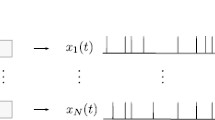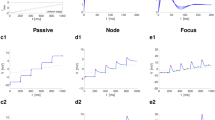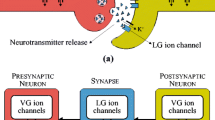Abstract
At the level of individual neurons, various coding properties can be inferred from the input-output relationship of a cell. For small inputs, this relation is captured by the phase-response curve (PRC), which measures the effect of a small perturbation on the timing of the subsequent spike. Experimentally, however, an accurate experimental estimation of PRCs is challenging. Despite elaborate measurement efforts, experimental PRC estimates often cannot be related to those from modeling studies. In particular, experimental PRCs rarely resemble the characteristic theoretical PRC expected close to spike initiation, which is indicative of the underlying spike-onset bifurcation. Here, we show for conductance-based model neurons that the correspondence between theoretical and measured phase-response curve is lost when the stimuli used for the estimation are too large. In this case, the derived phase-response curve is distorted beyond recognition and takes on a generic shape that reflects the measurement protocol and masks the spike-onset bifurcation. We discuss how to identify appropriate stimulus strengths for perturbation and noise-stimulation methods, which permit to estimate PRCs that reliably reflect the spike-onset bifurcation – a task that is particularly difficult if a lower bound for the stimulus amplitude is dictated by prominent intrinsic neuronal noise.




Similar content being viewed by others
References
Achuthan, S., Butera, R.J., Canavier, C.C. (2011). Synaptic and intrinsic determinants of the phase resetting curve for weak coupling. Journal of Computational Neuroscience, 30(2), 373–390.
Akam, T., Oren, I., Mantoan, L., Ferenczi, E., Kullmann, D.M. (2012). Oscillatory dynamics in the hippocampus support dentate gyrus-CA3 coupling. Nature Neuroscience, 15(5), 763–768.
Blankenburg, S., Wu, W., Lindner, B., Schreiber, S. (2015). Information filtering in resonant neurons. Journal of Computational Neuroscience, 39(3), 349–370.
Brown, E., Moehlis, J., Holmes, P. (2004). On the phase reduction and response dynamics of neural oscillator populations. Neural Computation, 16(4), 673–715.
Diba, K., Lester, H.A., Koch, C. (2004). Intrinsic noise in cultured hippocampal neurons: experiment and modeling. Journal of Neuroscience, 24(43), 9723–9733.
Ermentrout, G.B., Galán, R.F., Urban, N.N. (2008). Reliability, synchrony and noise. Trends in Neurosciences, 31(8), 428–434.
Ermentrout, G.B., & Kopell, N. (1991). Multiple pulse interactions and averaging in systems of coupled neural oscillators. Journal of Mathematical Biology, 29(3), 195–217.
Ermentrout, B. (1996). Type I membranes, phase resetting curves, and synchrony. Neural Computation, 8(5), 979–1001.
Ermentrout, G.B., & Terman, D.H. (2010). Mathematical foundations of neuroscience. Berlin: Springer Science & Business Media.
Farries, M.A., & Wilson, C.J. (2012a). Biophysical basis of the phase response curve of subthalamic neurons with generalization to other cell types. Journal of Neurophysiology, 108 (7), 1838– 1855.
Farries, M.A., & Wilson, C.J. (2012b). Phase response curves of subthalamic neurons measured with synaptic input and current injection. Journal of Neurophysiology, 108 (7), 1822– 1837.
Fellous, J.M., Houweling, A.R., Modi, R.H., Rao, R., Tiesinga, P., Sejnowski, T.J. (2001). Frequency dependence of spike timing reliability in cortical pyramidal cells and interneurons. Journal of Neurophysiology, 85 (4), 1782–1787.
Galán, R.F., Ermentrout, G.B., Urban, N.N. (2005). Efficient estimation of phase-resetting curves in real neurons and its significance for neural-network modeling. Physical Review Letters, 94(15), 158101.
Goldberg, J.A., Deister, C.A., Wilson, C.J. (2007). Response properties and synchronization of rhythmically firing dendritic neurons. Journal of Neurophysiology, 97(1), 208–219.
Govaerts, W., & Sautois, B. (2006). Computation of the phase response curve: a direct numerical approach. Neural Computation, 18(4), 817–847.
Guevara, M.R., Glass, L., Shrier, A. (1981). Phase locking, period-doubling bifurcations, and irregular dynamics in periodically stimulated cardiac cells. Science, 214 (4527), 1350– 1353.
Gutkin, B.S., Ermentrout, G.B., Reyes, A.D. (2005). Phase-response curves give the responses of neurons to transient inputs. Journal of Neurophysiology, 94(2), 1623–1635.
Hansel, D., Mato, G., Meunier, C. (1995). Synchrony in excitatory neural networks. Neural Computation, 7(2), 307–337.
Hesse, J., Schleimer, J.H., Schreiber, S. (2017). Qualitative changes in phase-response curve and synchronization at the saddle-node loop bifurcation. Physical Review E, 95(5), 052203–25.
Hodgkin, A.L., & Huxley, A.F. (1952). A quantitative description of membrane current and its application to conduction and excitation in nerve. The Journal of Physiology, 117(4), 500–544.
Izhikevich, E.M. (2000). Neural excitability, spiking and bursting. International Journal of Bifurcation and Chaos, 10(6), 1171–1266.
Izhikevich, E.M. (2007). Dynamical systems in neuroscience. Cambridge: MIT Press.
Kuramoto, Y. (1984). Chemical oscillations, waves and turbulence. Berlin: Springer Science & Business Media.
Lazar, A.A. (2007). Information representation with an ensemble of Hodgkin-Huxley neurons. Neurocomputing, 70(10–12), 1764–1771.
Mainen, Z.F., & Sejnowski, T.J. (1995). Reliability of spike timing in neocortical neurons. Science, 268(5216), 1503–1506.
Manwani, A., & Koch, C. (1999). Detecting and estimating signals in noisy cable structures, ii: information theoretical analysis. Neural Computation, 11(8), 1831–1873.
Minors, D.S., Waterhouse, J.M., Wirz-Justice, A. (1991). A human phase-response curve to light. Neuroscience Letters, 133(1), 36–40.
Netoff, T.I., Acker, C.D., Bettencourt, J.C., White, J.A. (2005). Beyond two-cell networks: experimental measurement of neuronal responses to multiple synaptic inputs. Journal of Computational Neuroscience, 18(3), 287–295.
Netoff, T.I., Banks, M.I., Dorval, A.D., Acker, C.D., Haas, J.S., Kopell, N., White, J.A. (2005). Synchronization in hybrid neuronal networks of the hippocampal formation. Journal of Neurophysiology, 93(3), 1197–1208.
Netoff, T.I., Schwemmer, M.A., Lewis, T.J. (2011). Experimentally estimating phase response curves of neurons: theoretical and practical issues. In Schultheiss, N.W., Prinz, A.A., Butera, R.J. (Eds.) Phase Response Curves in Neuroscience: theory, Experiment, and Analysis, (Vol. 5 pp. 95–129). Berlin: Springer Science & Business Media.
Nicholson, E., Kuzmin, D.A., Leite, M., Akam, T.E., Kullmann, D.M. (2018). Analogue closed-loop optogenetic modulation of hippocampal pyramidal cells dissociates gamma frequency and amplitude. eLife, 7, e38346.
Ota, K., Nomura, M., Aoyagi, T. (2009). Weighted spike-triggered average of a fluctuating stimulus yielding the phase response curve. Physical Review Letters, 103(2), 024101.
Phoka, E., Cuntz, H., Roth, A., Häusser, M. (2010). A new approach for determining phase response curves reveals that purkinje cells can act as perfect integrators. PLoS Comput Biol, 6(4), e1000768.
Razali, N., & Wah, Y.B. (2011). Power comparisons of Shapiro-Wilk, Kolmogorov-Smirnov, Lilliefors and Anderson-Darling tests. Journal of Statistical Modeling and Analytics., 2 (1), 21– 33.
Reyes, A.D., & Fetz, E.E. (1993a). Effects of transient depolarizing potentials on the firing rate of cat neocortical neurons. Journal of Neurophysiology, 69(5), 1673–1683.
Reyes, A.D., & Fetz, E.E. (1993b). Two modes of interspike interval shortening by brief transient depolarizations in cat neocortical neurons. Journal of Neurophysiology, 69 (5), 1661– 1672.
Rinzel, J., & Ermentrout, G.B. (1989). Analysis of neural excitability and oscillations, (pp. 135–169). Cambridge: MIT Press.
Schleimer, J.H., & Stemmler, M. (2009). Coding of information in limit cycle oscillators. Physical Review Letters, 103(24), 248105.
Schleimer, J.H., & Schreiber, S. (2018). Phase-response curves of ion channel gating kinetics. Mathematical Methods in the Applied Sciences, 41(18), 8844–8858.
Schreiber, S., Samengo, I., Herz, A.V.M. (2009). Two distinct mechanisms shape the reliability of neural responses. Journal of Neurophysiology, 101(5), 2239–2251.
Schultheiss, N.W., Prinz, A.A., Butera, R.J. (2011). Phase response curves in neuroscience: theory, experiment and analysis. Berlin: Springer Science & Business Media.
Smeal, R.M., Ermentrout, G.B., White, J.A. (2010). Phase-response curves and synchronized neural networks. Philosophical Transactions of the Royal Society B: Biological Sciences, 365(1551), 2407–2422.
Stiefel, K.M., & Ermentrout, G.B. (2016). Neurons as oscillators. Journal of Neurophysiology, 116(6), 2950–2960.
Stimberg, M., Goodman, D.F.M., Benichoux, V., Brette, R. (2014). Equation-oriented specification of neural models for simulations. Frontiers in Neuroinformatics, 8, 6.
Teramae, Jn., & Fukai, T. (2008). Temporal precision of spike response to fluctuating input in pulse-coupled networks of oscillating neurons. Physical Review Letters, 101(24), 248105.
Torben-Nielsen, B., Uusisaari, M., Stiefel, K.M. (2010a). A Comparison of methods to determine neuronal phase-response curves. Frontiers in Neuroinformatics 4.
Torben-Nielsen, B., Uusisaari, M., Stiefel, K.M. (2010b). A novel method for determining the phase-response curves of neurons based on minimizing spike-time prediction error. arXiv:10010446 [q-bio].
Tsubo, Y., Takada, M., Reyes, A.D., Fukai, T. (2007). Layer and frequency dependencies of phase response properties of pyramidal neurons in rat motor cortex. European Journal of Neuroscience, 25(11), 3429–3441.
Van Vreeswijk, C., Abbott, L.F., Ermentrout, G.B. (1994). When inhibition not excitation synchronizes neural firing. Journal of Computational Neuroscience, 1(4), 313–321.
Wang, X.J., & Buzsáki, G. (1996). Gamma oscillation by synaptic inhibition in a hippocampal interneuronal network model. The Journal of Neuroscience, 16(20), 6402–6413.
Wang, S., Musharoff, M.M., Canavier, C.C., Gasparini, S. (2013). Hippocampal CA1 pyramidal neurons exhibit type 1 phase-response curves and type 1 excitability. Journal of Neurophysiology, 109(11), 2757–2766.
White, J.A., Klink, R., Alonso, A., Kay, A.R. (1998). Noise from voltage-gated ion channels may influence neuronal dynamics in the entorhinal cortex. Journal of Neurophysiology, 80(1), 262–269.
Acknowledgements
The study was funded by the German Federal Ministry of Education and Research (Grant No. 01GQ1403) and the German Research Foundation (GRK 1589). We thank Paul Pfeiffer for valuable feedback on the manuscript.
Author information
Authors and Affiliations
Corresponding author
Ethics declarations
Conflict of interests
The authors declare that they have no conflict of interest.
Additional information
Action Editor: Nicolas Brunel
Publisher’s note
Springer Nature remains neutral with regard to jurisdictional claims in published maps and institutional affiliations.
Appendices
Appendix: Conductance-based neuron models
Conductance-based neuron models were based on established models from the literature. The Hopf model was first described by Morris and Lecar; we use the version from Ermentrout and Terman (2010), p. 50-51. The SNIC and HOM models are versions of the Wang-Buzsaki model (Wang and Buzsáki 1996). The membrane voltage v of the models follows the dynamics
The input current is the sum of a DC current, a time-dependent stimulus and an intrinsic noise ξ, Iin = IDC + s(t) + σξ. For simulations without intrinsic noise, σ = 0. The model parameters are summarized in Table 1.
Gating for the Hopf model:
For the Hopf model,
The kinetics of the ion channel gating n are given by
with τn(v) = 1ms/cosh ((v/mV − 2)/60). The ion channel activation curves are given as
2.1 Gating for the SNIC and HOM models:
For the SNIC model,
The kinetics of the ion channel gating are given by
with
The ion channel activation curve for the gating variable m is given as
The HOM model is equivalent to the SNIC model, but with ϕ = 1.5 and Iin = 0.166μ A/cm2, for more details see Hesse et al. (2017).
Conductance-based neuron models were simulated numerically with the simulation environment brian2 (Stimberg et al. 2014). To record 500 perturbed spikes, the recording duration is 50 seconds for the noise-stimulation methods, and 100 seconds for the perturbation method, where only every second spike is perturbed. We observed that the interspike interval depends on the time resolution dt of the simulation. We have chosen dt = 0.001ms for all models, to ensure that a three times smaller time step changed the deterministic interspike interval by less than 5%.
To investigate the tolerance of PRC measurements towards an unknown noise source, PRCs were in a second step measured for neuron models that included intrinsic noise, implemented as an additive zero-mean white-noise current (the brian2-implemented variable xi). The noise levels chosen in this study correspond to relatively strong intrinsic noise, with a phase noise of \(\tilde {\sigma } = 2\sqrt {\text {ms}}\) or \(\tilde {\sigma } = 3\sqrt {\text {ms}}\) standard deviation (Fig. 4). The next section shows how to translate the phase noise into the standard deviation of the brian2-implemented noise variable xi. The chosen phase noise results in a CV of around 0.2 and 0.3, respectively, which is within a biologically realistic range.
As a side-note, while the stimulus amplitude appropriate for PRC estimation is larger for perturbations than for a noise stimulus, the latter induce more spike jitter (larger CVs) compared to the perturbations. It seems that as the perturbation is temporally precise, even small spike deviations are sufficient to estimate PRCs, while the continuous input delivered by the noise stimulus requires larger deviations to estimate the PRC, probably because every spike informs about the full phase range, instead of just one particular phase.
2.2 Adaptation of intrinsic noise levels for brian2 models
Comparable levels of spike jitter between models can be ensured by balancing the effective phase noise. Let η(t) be a zero-mean white noise current with standard deviation 1. As intrinsic noise current of the neuron model, we chose ση(t) with standard deviation σ. The phase Eq. (1) is \(\dot {\varphi }(t) = 1 + Z s(t)\) with current input s(t) and PRC Z. With the intrinsic noise as input, s(t) = ση(t), and under the assumption that the intrinsic noise is weak, and thus influences φ much less than the deterministic dynamics, one can replace the temporally precise filtering of the noise by its averaged effect in one interspike interval (Schleimer and Stemmler 2009). We get \(\dot {\varphi }(t) = 1 + \tilde {\sigma } \eta (t)\), with the variance of the white noise as \(\tilde {\sigma }^{2} = \sigma ^{2} {\int _{0}^{1}} Z^{2}(\varphi ) \text {d}\varphi \).
Setting the phase noise \(\tilde {\sigma }\) to the same value in all models, we find the appropriate current noise strength as \(\sigma = \tilde {\sigma } \frac {C_{\text {m}}}{T} \left [\int _{0}^{1} Z^{2}(\varphi ) \text {d}\varphi \right ]^{-0.5}\), where Cm is the membrane capacitance of the model. For the simulations, we evaluate this formula with the theoretical iPRCs gained from backwards integration of the adjoint equation as Z, see Section 2.3.
2.3 Error estimation by bootstrapping
In order to evaluate the quality of the PRC, we use a bootstrap approach to estimate errors for the phase response curves. Two different kinds of phase-dependent errors are considered, the baseline error which results from PRC estimates on shuffled data, and the error on the PRC estimate.
In order to provide an error for the PRC, we repetitively estimate PRCs using only a restricted amount of spikes. We estimated PRCs in 100 repetitions from a set about 250 spikes, randomly chosen from the total set of about 500 perturbed spikes. The standard deviation of the 100 PRC estimates was used as PRC error.
In order to provide a baseline for the PRC estimate – above which a significant PRC should rise – we measure PRCs for random combinations of noise snippets and spike advances. We measure the PRC in 100 repetitions for a random permutation of the numbering i of spike deviations {Δφi}, and calculate the standard deviation for the resulting 100 estimates. The mean of these estimates results in a PRC close to zero, such that the resulting standard deviation corresponds to the range within which a zero, i.e., non-significant PRC estimate is to be expected. This error around zero provides a lower bound to PRCs that are significantly different from zero.
2.4 Amplitude scaling for estimated phase-response curves
The appropriate unit for most experimentally derived PRCs is Hz cm2/μ A, which naturally arises for PRCs that measure the phase advance in response to a current per surface area, such as a noise stimulus or perturbation in μ A/cm2. For this study, however, we aim at comparing experimentally measured PRCs with theoretical iPRCs. The theoretical iPRCs gained from backwards integration of the adjoint equation have a unit of 1/mV, as they quantify the phase advance in response to a voltage perturbation in units of mV. For comparison, we transform the estimated PRCs into the units of the theoretical iPRCs by multiplying the current PRC by the membrane capacitance, ZΔv = ZΔICm
Rights and permissions
About this article
Cite this article
Hesse, J., Schreiber, S. How to correctly quantify neuronal phase-response curves from noisy recordings. J Comput Neurosci 47, 17–30 (2019). https://doi.org/10.1007/s10827-019-00719-3
Received:
Revised:
Accepted:
Published:
Issue Date:
DOI: https://doi.org/10.1007/s10827-019-00719-3




